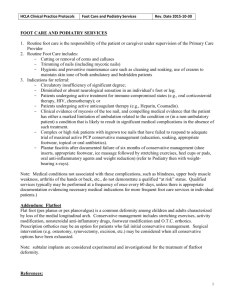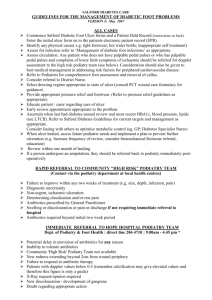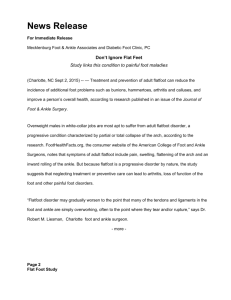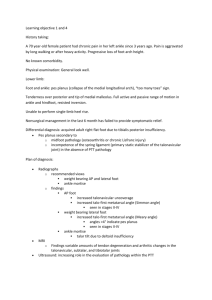Foot-Care-and-Podiatry-Services
advertisement
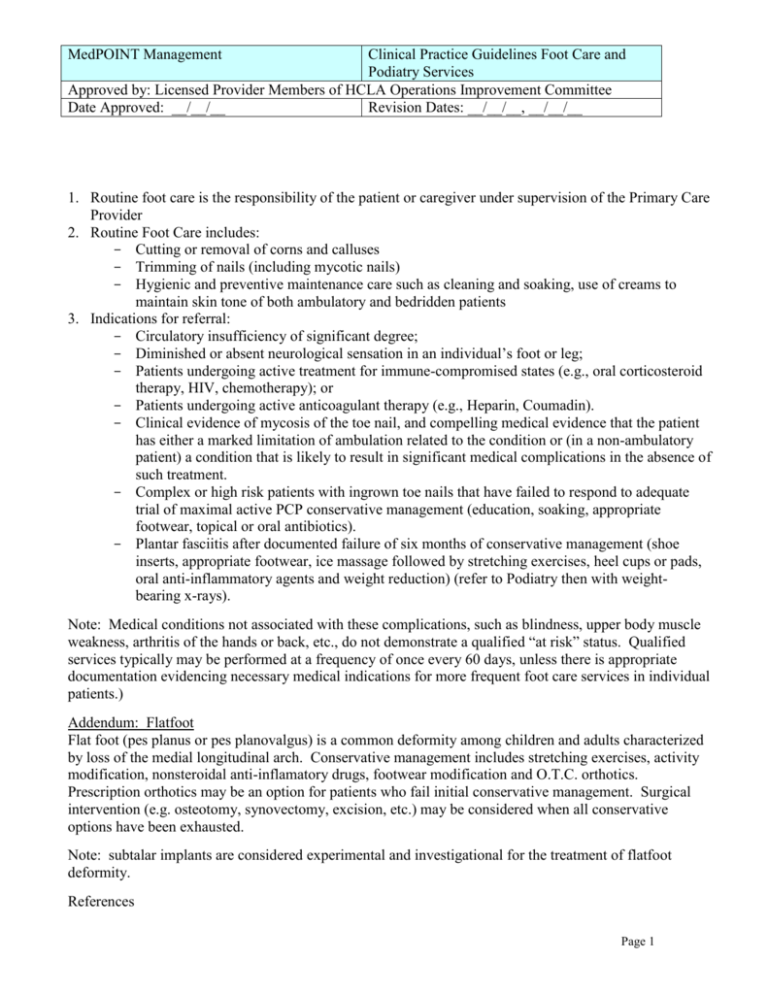
MedPOINT Management Clinical Practice Guidelines Foot Care and Podiatry Services Approved by: Licensed Provider Members of HCLA Operations Improvement Committee Date Approved: __/__/__ Revision Dates: __/__/__, __/__/__ 1. Routine foot care is the responsibility of the patient or caregiver under supervision of the Primary Care Provider 2. Routine Foot Care includes: - Cutting or removal of corns and calluses - Trimming of nails (including mycotic nails) - Hygienic and preventive maintenance care such as cleaning and soaking, use of creams to maintain skin tone of both ambulatory and bedridden patients 3. Indications for referral: - Circulatory insufficiency of significant degree; - Diminished or absent neurological sensation in an individual’s foot or leg; - Patients undergoing active treatment for immune-compromised states (e.g., oral corticosteroid therapy, HIV, chemotherapy); or - Patients undergoing active anticoagulant therapy (e.g., Heparin, Coumadin). - Clinical evidence of mycosis of the toe nail, and compelling medical evidence that the patient has either a marked limitation of ambulation related to the condition or (in a non-ambulatory patient) a condition that is likely to result in significant medical complications in the absence of such treatment. - Complex or high risk patients with ingrown toe nails that have failed to respond to adequate trial of maximal active PCP conservative management (education, soaking, appropriate footwear, topical or oral antibiotics). - Plantar fasciitis after documented failure of six months of conservative management (shoe inserts, appropriate footwear, ice massage followed by stretching exercises, heel cups or pads, oral anti-inflammatory agents and weight reduction) (refer to Podiatry then with weightbearing x-rays). Note: Medical conditions not associated with these complications, such as blindness, upper body muscle weakness, arthritis of the hands or back, etc., do not demonstrate a qualified “at risk” status. Qualified services typically may be performed at a frequency of once every 60 days, unless there is appropriate documentation evidencing necessary medical indications for more frequent foot care services in individual patients.) Addendum: Flatfoot Flat foot (pes planus or pes planovalgus) is a common deformity among children and adults characterized by loss of the medial longitudinal arch. Conservative management includes stretching exercises, activity modification, nonsteroidal anti-inflamatory drugs, footwear modification and O.T.C. orthotics. Prescription orthotics may be an option for patients who fail initial conservative management. Surgical intervention (e.g. osteotomy, synovectomy, excision, etc.) may be considered when all conservative options have been exhausted. Note: subtalar implants are considered experimental and investigational for the treatment of flatfoot deformity. References Page 1 MedPOINT Management Clinical Practice Guidelines Foot Care and Podiatry Services Approved by: Licensed Provider Members of HCLA Operations Improvement Committee Date Approved: __/__/__ Revision Dates: __/__/__, __/__/__ Apollo Managed Care Consultants, “Medical Review Criteria Guidelines for Managing Care”, Eighth Edition, pp. 991-993. Health Net, National Medical Policy, “Subtalar Implant for Treatment of pes Planus (Flatfeet)”, NMP427, Aug 2009, July 2010. Aetna, Clinical Policy Bulletin, “Subtalar Implant for Foot Deformity”, 11/16/10. Anthem Medical Policy, “Subtalar Arthroereisis”, Surg.00104, 10/13/10. Page 2
